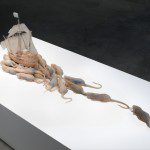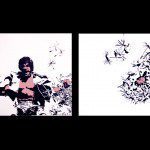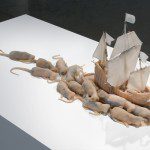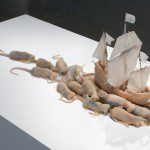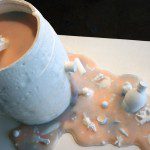In viewing Scott Yoell’s work, one is prompted to more closely examine the physical and metaphysical states of their own proximate societies. Confronting the ideological agendas of culture production, and especially the production of artificial cultural paradises, Yoell explores issues pertinent to a variety of disciplines and concerns including the construction and consumption of visual culture and media.
In his body of work Abstractions of a Paradigm Yoell utilizes sculpture, installation, drawing and time-based video and sound to explore and critique humankind’s relationship with the world it has constructed and with the natural world. Works such as A Fiction of Paradise, 2007 and What Remains?, 2008 look at the spaces in between: the discarded, the forgotten, the ignored, and the temporally fragile. Notions of lapsed time and detritus settle into these works and establish an uneasy correspondence between excessive human desires and the natural world.
A Fiction of Paradise, 2007 exudes a clinically detached aesthetic. In this diptych, Yoell’s palette is limited to black, grey and flesh tone. The image of a deceased albatross on the left and the contents of its dissected stomach on the right are realistically rendered, and recall medical illustrations common in textbooks and encyclopedias. This visual relation to scientific data conveys notions of indisputable truth, evidence and invention. Yoell appears savvy to the stereotypical notions of optimistic progress associated with scientific activity and turns this knowledge toward a critique of cultural activities taking similar liberties. The bird’s stomach is shown to contain an enormous accumulation of plastic memorabilia often associated with tourism. The inability of the animal to digest these human-made products creates a tension between the natural (bird) and the unnatural or human-made (plastic). The fact that one bird could be so overrun with and possibly have died as a result of these leftover cultural artifacts seems to point blatantly to our overproduction and inability to cohabit with our natural world.
What Remains?, 2008 similarly critiques the idea of humanity’s self-constructed waste. The piece metaphorically depicts the North Pacific Gyre, a section of the Pacific Ocean whose swirling current has collected and held onto many miles of superfluous products of human consumption. The plastic and silicon used to construct the piece aptly reflect the composition of many of the items found in the actual North Pacific Gyre. Similar to A Fiction of Paradise, 2007 and the other pieces in Abstractions of a Paradigm, this work serves as a reminder of the way we cyclically produce, use and discard our cultural surroundings, and questions the necessity of the initial production.



